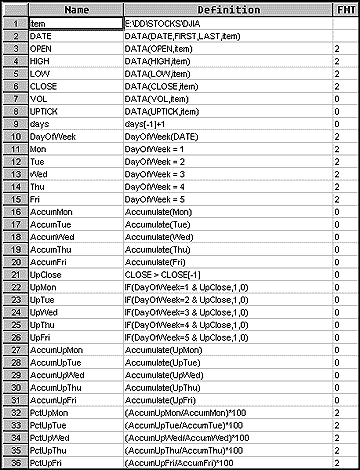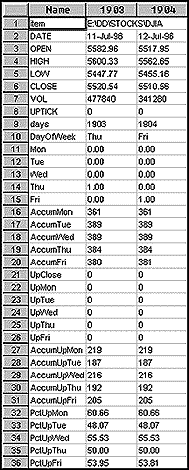21 period regression slope
(((Sum(Cum(1)*C,21))-(Sum(Cum(1),21)*Sum(C,21)/21))/
((Sum(Power(Cum(1),2),21))-(Power(Sum(Cum(1),21),2)/21)))
21 period %A
((C-Fml("21 period lower band (smoothed)"))/(Fml("21 period
upper band (smoothed)")-Fml("21 period lower band
(smoothed)")))
21 period R2 (smoothed)
Mov((Pwr(Corr(Cum(1),C,21,0),2)),3,S)
21 period upper band (smoothed)
Mov((21 * Sum(Cum(1) * C,21) - Sum(Cum(1),21) * Sum(C,21)) /
(21 * Sum(Pwr(Cum(1),2),21) - Pwr(Sum(Cum(1),21),2)) *
Cum(1) + (Mov(C,21,S) - Mov(Cum(1),21,S) * (21 *
Sum(Cum(1) * C,21) - Sum(Cum(1),21) * Sum(C,21)) / (21 *
Sum(Pwr(Cum(1),2),21) - Pwr(Sum(Cum(1),21),2))) +
2*(Sqrt(((Sum(Power(C,2),21)-(Power(Sum(C,21),2)/21)) -
((Sum(Cum(1)*C,21))-((Sum(Cum(1),21)*Sum(C,21)/21)))/
((Sum(Power(Cum(1),2),21))-(Power(Sum(Cum(1),21),2)/
21))*((Sum(Cum(1)*C,21))-((Sum(Cum(1),21)*Sum(C,21)/
21)))) /19)),3,S)
21 period regression (smoothed)
Mov((21*Sum(Cum(1)*C,21)-Sum(Cum(1),21)*Sum(C,21))/
(21*Sum(Pwr(Cum(1),2),21)-Pwr(Sum(Cum(1),21),2))*Cum(1)
+(Mov(C,21,S)-Mov(Cum(1),21,S)*(21*Sum(Cum(1)*C,21) -
Sum(Cum(1),21)*Sum(C,21))/(21*Sum(Pwr(Cum(1),2),21)-
Pwr(Sum(Cum(1),21),2))),3,S)
21 period lower band (smoothed)
Mov((21 * Sum(Cum(1) * C,21) - Sum(Cum(1),21) * Sum(C,21)) /
(21 * Sum(Pwr(Cum(1),2),21) - Pwr(Sum(Cum(1),21),2)) *
Cum(1) + (Mov(C,21,S) - Mov(Cum(1),21,S) * (21 *
Sum(Cum(1) * C,21) - Sum(Cum(1),21) * Sum(C,21)) / (21 *
Sum(Pwr(Cum(1),2),21) - Pwr(Sum(Cum(1),21),2))) -
2*(Sqrt(((Sum(Power(C,2),21)-(Power(Sum(C,21),2)/21)) -
((Sum(Cum(1)*C,21))-((Sum(Cum(1),21)*Sum(C,21)/21)))/
((Sum(Power(Cum(1),2),21))-(Power(Sum(Cum(1),21),2)/
21))*((Sum(Cum(1)*C,21))-((Sum(Cum(1),21)*Sum(C,21)/
21)))) /19)),3,S)
Binary bandwidth indicator
If((ATR(55)/(BBandTop(C,21,S,2)-
BBandBot(C,21,S,2)))>.50,+1,0)
-- Jon Andersen, Equis International
GO BACK
A: DATE 'Read in price data
B: HIGH
C: LOW
D: CLOSE
E: OPEN
F: VOL
G: Trend @LREG(CLOSE,21,0) 'Regression
H: StdErr @LREG(CLOSE,21,9) 'Standard error
I: SmoRegr @MAVG(Trend,3) 'Smooth regression
J: SmoStEr @MAVG(StdErr,3) 'Smooth std error
K: HiBand SmoRegr+2*SmoStEr 'Upper band
L: LoBand SmoRegr-2*SmoStEr 'Lower band
M: %A 100*(CLOSE-LoBand)/(HiBand-LoBand)
N: RSQ @LREG(CLOSE,21,2) 'R-squared
O: SmoRSQ @MAVG(RSQ,3) 'Smooth R-squared
P: Slope @LREG(CLOSE,21,1) 'Regression slope
Q: Avg21 @MAVG(CLOSE,21)
R: BolBHi AVG21+2*@STD(CLOSE,21) 'Bollinger high band
S: BolBLo AVG21-2*@STD(CLOSE,21) 'Bollinger low band
T: TrueR @TR(HIGH,LOW,CLOSE,1) 'True range
U: AvgTR @MAVG(TrueR, 55) 'Average of true range
V: AlertR AvgTR/(BolBHi - BolBLo) 'The alert ratio
W: AlertLv @IF(AlertR >= 0.50, 1, 0) 'Alert ratio level hit
The use of linear regression and standard error are sound statistical measures. The standard error acts as a standard deviation above and below the regression line. However, the use of moving average smoothing in the above calculations distorts this method's statistical accuracy.
-- Peter Di Girolamo, Jerome Technology
GO BACK
![]() METASTOCK
METASTOCK ![]() TECHNIFILTER PLUS
TECHNIFILTER PLUS ![]() WAVEWI$E MARKET SPREADSHEET
WAVEWI$E MARKET SPREADSHEET ![]() SMARTRADER
SMARTRADER ![]() TRADESTATION
TRADESTATION

